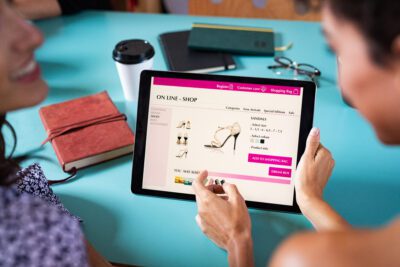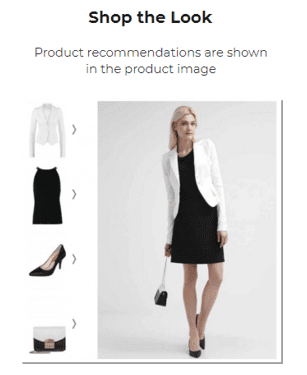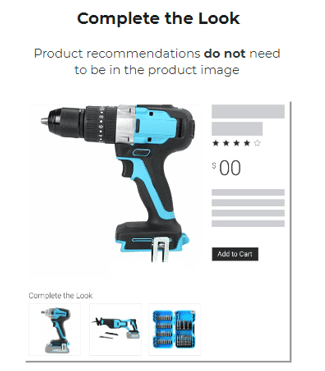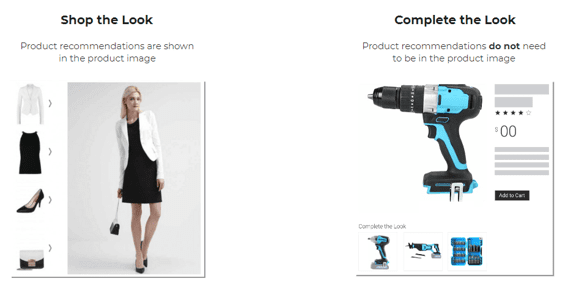
Shop the Look vs. Complete the Look: What’s the Difference?
As most retail merchandisers know, suggesting complementary products and product groups increases sales and average order values (AOVs). This is true both online and off. In a digital setting, recommended products can be showcased using two effective merchandising approaches – “Shop the Look” and “Complete the Look.”
Both product bundling strategies are incredibly effective, but they serve different purposes. Without understanding the difference – including when to leverage one over the other – you may be missing out on maximizing the effectiveness of each approach.
In this post, we define what sets these two visually-driven merchandising strategies apart and provide some guidance on how they’re used, the qualities of each, and their benefits. You’ll walk away with clarity around each approach which you can then integrate into your product merchandising strategy.
What is “Shop the Look”?
“Shop the look” is a dynamic product bundling feature included in some ecommerce and personalization platforms that lets retailers curate multiple products as a bundled style. The products, while shown together, are each “clickable” to allow customers to easily learn more about a given product or add the entire bundle to their cart. Here is an example of what that looks like on a retailer’s website:
In the above example, the retailer is styling a dress with a jacket, shoes, and accessories to create a complete outfit. The items are featured on a model, so the shopper can visualize them as a finished look. Each item can be clicked on to view more details or added to the shopper’s cart.
The goal with “Shop the Look”, or any bundling strategy, is to expand the shopper’s perspective – to help them discover products. Seeing how products work together inspires and motivates people to buy more than a single item. It also makes a compelling case to the customer for purchasing more items, plus bundled groups remove friction. It’s easy for shoppers to purchase the separate pieces as a single outfit.
What is “Complete the Look”?
“Complete the Look” differs from “Shop the Look” in that it features a single hero product (e.g., the item a shopper is looking at in the moment) along with recommended items that complement it. “Complete the Look” recommendations are typically add-ons meant to incrementally increase order values. Here is an example of what “Complete the Look” might look like on a retailer’s website:
In the above example, the drill is the main “hero” product with drill bits and other add-ons shown beneath it. This works very well for any type of tool or electronic. For example, if you’re selling a camera, you could recommend additional batteries, memory cards, camera bags, lenses, and tripods as complementary products. These items enhance or expand the capabilities and usage of the camera.
The benefit of “Complete the Look” is that it offers customers helpful, relevant suggestions at checkout, without being too overwhelming. The focus stays on the hero product, while presenting logical complementary items for customers to consider. Recommendations can increase average order value, though conversion rates may not improve as dramatically as a full lifestyle “Shop the Look” concept.
Shop the Look vs. Complete the Look
While both “Shop the Look” and “Complete the Look” merchandising strategies aim to increase sales, there are some key differences between them. Here’s a side-by-side comparison of the above examples:
Here’s a breakdown of the key features and benefits for each:
Shop the Look Features
- Showcases a complete outfit or fully styled look
- Features multiple complementary products styled together like an outfit on a model or a living room staged with rugs, end tables, and lamps.
- Creates an aspirational lifestyle concept, inspires, sparks ideas
- Products are clickable so customers can easily shop an entire look
- Higher total ticket value may be intimidating
Benefits:
- Inspires customers to envision how a product or outfit fits into their lifestyle
- Encourages larger basket sizes by helping customers see what types of complimentary products are available
- Allows easier shopping of a whole look
- Provides tangibility to how a single product could be used or worn alongside what the customer may already own.
- Makes inventory more discoverable by displaying items that a shopper may not know about (or be considering).
Complete the Look Features
- Highlights a single hero product like a camera or dress
- Recommends accessories and add-ons that enhance the main product
- Keeps the focus on a hero product, while tempting with extras
- Can increase order values without being overwhelming
- May not dramatically improve conversion rates
Benefits:
- Increases order values by tempting customers with logical, incremental add-on purchases that enhance the main product
- Surfaces useful, related products that customers may not have considered, helping them fully utilize the hero product
- Keeps focus on the hero product so customer attention stays on the main purchase, while presenting complementary options
The optimal merchandising approach depends on product type, average order value, and typical cross-sell success. Offering both “Shop the Look” and “Complete the Look” gives you the most flexibility around merchandising products based on what resonates best with your customers.

How Can Complete the Look Help Me Curate Product Sets at Scale?
Manually curating complementary product sets is extremely time and resource intensive, particularly if your catalog contains thousands – or tens of thousands – of products. Add to this that inventory is constantly fluctuating and consumer behaviors shift with trends and seasons. That makes manual product grouping an endless hamster wheel of trying to keep up.
Dynamic bundles, a type of automated product bundling, can help you manage this challenge. Monetate’s new “Complete the Look” offering is a great example of smart dynamic bundling in action. It helps merchandising teams curate meaningful product sets through automation. The feature combines human merchandising expertise with AI-powered recommendation algorithms. “Complete the Look” automatically generates personalized, high-quality product bundles that evolve in real-time based on availability, seasonality, and customer data.
“Complete the Look” isn’t meant to replace your merchandisers. It’s a tool that enhances manual efforts by drastically increasing catalog coverage. The output aligns with your brand guidelines, while requiring far less ongoing oversight once configured. Merchandising teams gain capacity to focus on hero placements while “Complete the Look” works behind the scenes to scale curation across the long tail of catalogue products.
Our “Complete the Look” offering is designed to work alongside other automated bundling and product recommendations features. Our aim is help you considerably reduce the time spent on manual merchandising, while improving product findability, AOV, and catalog exposure. We’d love to tell you more. If you’re interested in learning about our “Complete the Look” offering or want to discuss how dynamic product bundles can empower your merchandising team, schedule a demo or reach out to schedule a consult.


